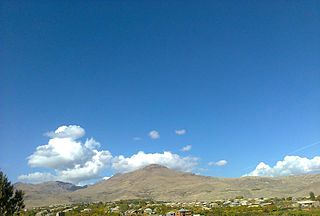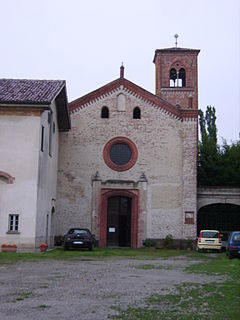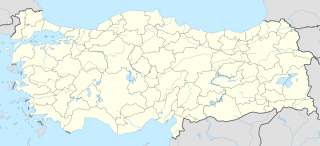
Iqalto is a village about 10 km west of the town Telavi in the Kakheti region of Eastern Georgia. It is mostly known for its monastery complex and the Ikalto Academy.

The Province of Monza and Brianza,, is an administrative province of Lombardy region, Italy.

Yagha is one of the 45 provinces of Burkina Faso, located in its Sahel Region.

Siklós is the 4th largest town in Baranya county, Hungary. 45°51′19″N18°17′55″E.

The Church of the Holy Spirit is a church located in the district of Klostergården, on the south-west side of Lund in Skåne, Sweden. It was opened in 1968 as a district church in the Diocese of Lund, but became the main church of the parish of Helgeand after it was formed in 1991.

Mets Masrik is a town in the Gegharkunik province of Armenia. The town has been inhabited since the 7th century and has a khachkar dated 881, two shrines from the 12th and 13th centuries, and a 17th-century church. Nearby is Pokr Masrik.

Assumption of Mary Parish Church in Dekani is the parish church of the Parish of Dekani, a village near the city of Koper in southwest Slovenia. It was built in 1229, rebuilt towards the end of the 15th century, consecrated in 1493, and restored and enlarged in 1902.

St. Bassus's Church is a church on Prešeren Square in Koper, a port town in southwestern Slovenia. It has the function of a chapel of the Parish of Koper–Assumption of Mary. The building, which dates from the end of the 16th century, at first served as a hospital of St. Nazarius and was consecrated as a church by Koper Bishop Paolo Naldini in 1706. It was significantly rebuilt in 1731. It has a Baroque interior with a single nave and a flat ceiling. The rich Baroque interior furnishings include the main altar with images of St. Nazarius and St. Bassus, a statue of St. Bassus in the vestry, and a Romanesque crucifix from about 1120, later Gothicised, that was believed to have miraculous powers. It is made of polychrome wood and depicts a triumphant Christ.

Ravnica is a village in western Slovenia in the Municipality of Nova Gorica. It is located on the high Trnovo Forest Plateau, overlooking the villages of Grgar and Čepovan.

Aghavnadzor is a village in the Areni Municipality of the Vayots Dzor Province in Armenia.

Holy Trinity Church is a historical building in Hrastovlje, a village in southwestern Slovenia. There are two hypotheses about its origin. According to the first, it is a Romanesque church from the 12th century. According to the second, it is an example of the Istrian variant of Early Venetian Renaissance architecture from the 15th century.

Tsrviz Chapel or Moro-Dzoro, is a medieval Armenian chapel located near the village of Lusahovit in the Tavush Province of Armenia.

Nosedo is a district ("quartiere") of the city of Milan, Italy. It is part of the Zone 4 administrative division, located south of the city centre. Until 1870, it was an autonomous comune. The name comes from the Latin nocetum, meaning "walnut forest", as walnut trees used to be common in the area.

Santa Maria della Passione is a late Renaissance-style church located in Milan, Italy.

Saint Spyridon Church is a Serbian Orthodox church in Trieste, Italy.

Mirasole Abbey is a monastery in the comune of Opera near Milan, Lombardy, Northern Italy. The monastery was initially founded by the Humiliati in the 13th-century. The buildings have had diverse uses over the centuries. Since 2013, houses a community of the Premonstratensians.
Mastaura was a town in ancient Lycia.
Tyriaeum or Tyriaion, also spelled Tyraion, was a Roman and Byzantine era civitas in the Roman Province of Pisidia, located ten parasangs from Iconium It was mentioned by Xenophon, and Pliny and Strabo tell us it was between Philomelium (Akshehr) and Laodicea Combusta. It is tentatively identified with ruins near modern Teke Kozağaçi (Turkey) on the road from Antalya to Denizli or near modern Ilgın.

Balabolu is a hill and an archaeological site on the hill in Mersin Province, Turkey.
This page is based on this
Wikipedia article Text is available under the
CC BY-SA 4.0 license; additional terms may apply.
Images, videos and audio are available under their respective licenses.


















